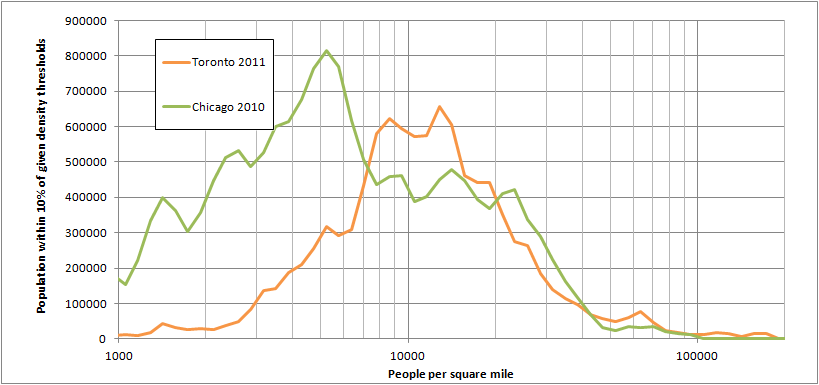No they're not... these are my numbers and they're for the Chicago Urban Area which has 9 million people to Toronto's 5.2 million.
Toronto using the US version of CMAs (MSAs) would still be quite a bit smaller than Chicago. MSAs are based on commuting patterns, and while their criteria are more generous than StatsCan's, you'd still end up with a lot less.
Chicago's MSA has about 9.5 million people.
Toronto's MSA would definitely have the whole GTA, plus Dufferin County. Using the 2006 census commuting numbers, that's it, Hamilton would be separate (similar to how Worcester is separate from Boston and at a similar distance). Using the 2011 National Household Survey, Kawartha Lakes would also qualify for the MSA, which requires 25% commuting into the core counties (which would be the GTA). Kawartha has 27%, so they're good. Hamilton has 24% so it just barely falls short. So you'd get around 6.1-6.2 million for the MSA.
Even if you want to be generous and add Hamilton despite the fact that it falls 1% short, which would make Hamilton a core county (since it's continuously urbanized with Toronto), and which would allow Haldimand to be part of the MSA too, since over 25% commute into Hamilton which would now be a core county. And then
on top of that you broke down Simcoe County into a Southern and Northern half (since it's a very big county by US standards), which would allow the southern half to join Toronto's MSA (whole county can't with only 20% commuting into the GTA), that still gives you
only about 6.9-7.0 million. So 2.5 million short of Chicago.
For the CSA, you'd have around 7.4 million using the 2011 NHS commuting patterns. Maybe 7.5 million if Hamilton is part of the MSA since that would allow you to add Brant County. Chicago would be 9.8-9.9 million.
To get to less than 1 million from Chicago, you'd have to add Wellington, Waterloo and Niagara Region, and then some (from where? Oxford County? Norfolk?). For Niagara and Waterloo Regions, it's still pretty low. Wellington it's high enough to qualify for the Toronto CSA, but it's more closely tied to Waterloo Region for commuting, and a city can only be in one CSA, so Wellington would go to Waterloo. Even you are supergenerous though, and add Wellington and Brant to the CSA, that's still just 7.7 million, more than 2 million short of Chicago.
You can't just say that because Chicago's CSA should cover x square miles, so should Toronto's. That's a double edged sword that would also allow Boston to baloon to 8.5 million, Miami to 9 million (stretching 500km to Daytona Beach, since it would be a narrow strip), Washington to 9.5 million, San Francisco to 10 million, Philadelphia to over 10 million... And to take it global, Shanghai might have 50 million, as would Delhi and Guangzhou. Or Al Mahallah Al Kubra in Egypt (population 450,000) is actually part of a metro area of 10 or 15 or 20 or 25 million... Because the Nile Delta is composed of towns of 10-20,000 p/km2 that are very close together, so you have densities of 3,000-5,000 p/km2 across much of the Delta, which holds about 30 million people if you exclude Cairo and Alexandria (located at the edge of the Delta region). And in this 30 million person region, Al Mahallah Al Kubra is the biggest city, but no-one would seriously contend that it's bigger than Toronto, or Chicago, or hell, New York, because the Nile Delta holds more people in the same amount of land area that these metro areas take up.
And by the way, Chicago doesn't need those 28,000 km2 (MSA land area) to be a big city. The urban area holds 8.9 million out of the 9.5 million MSA in just 5,500km2. So most of the MSA is just farmland that doesn' contribute much to the population.
The GTA by comparison is 7,100 km2. You could tweak the boundaries of the GTA, remove Brock, Scugog, Uxbridge, Georgina to make room for Hamilton or what not, but you'll still be around 6.5 million for a comparable 5,500km2 land area.
This is how some Canadian MSAs/CSAs would look based on 2006 census commuting patterns.
http://forum.skyscraperpage.com/showthread.php?p=6058472#post6058472







